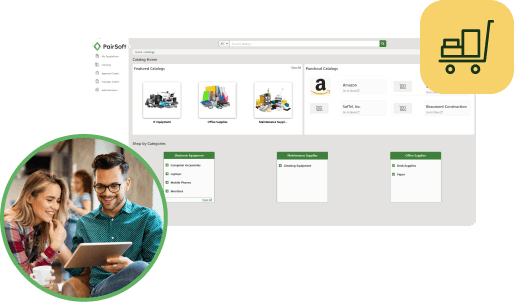
PairSoft
The strongest AP automation, document management, procurement, and fundraising automation platform for mid-market and enterprise companies with integrations to your ERP system.
View all posts by PairSoftPairSoft

The utilities industry has undergone profound changes over the past decades, from an upsurge in mergers and acquisitions to extensive market pressures to significant technology changes. In response to these changes, utility companies must hone and streamline their operations to remain viable, competitive, and profitable.
Procurement is one area that utility companies are taking a closer look at, with the goal of lowering costs, improving efficiency, and boosting staff productivity — primarily through the use of technology tools. Our colleagues at PayStream Advisors recently surveyed more than 400 utility companies about their procurement practices. As part of that survey, utility companies were asked to identify their top procurement process improvement goals. Here we take a closer look at the top 5 procurement goals in the utility industry identified in that survey, along with some steps utility companies can take to reach those goals more quickly.
Spend visibility was cited as the top improvement goal by 23% of utility organizations surveyed — and for a good reason. Companies that lose control of their spending can fail, and fail in big ways. Spend visibility is the first step in controlling and managing spending — as it provides both a big picture view and detailed insight into how money is moving through the organization. Spend visibility helps utility organizations:
Data accuracy likely makes every company’s list of goals — and utility companies are no exception. Fully 20% of utility companies surveyed cited data accuracy as a top procurement improvement goal. Data accuracy in this context is not limited to the utility companies’ data — including supplier data accuracy as well. In a 2016 report on Supplier Information Management by PayStream Advisors, the authors noted that “supplier data is the underlying foundation upon which an organization operates—and the quality, timeliness, and dependability of critical supplier data can make or break a company.” Some ways in which utility companies can help promote supplier data accuracy are:
According to Deloitte’s 2016 Global Chief Procurement Officer (CPO) Study, 74% of CPOs cited cost reduction as a strong business priority. In the above-referenced PayStream Advisors study, 18% of utility companies cited cost reduction as their top procurement improvement goal. Some ways utility companies can reduce procurement costs are to:
Overcomplicated workflows and procedures rob an organization of efficiency and its staff of productivity. Utility companies recognize the value in streamlining operations — in fact, 12% of utility companies cited this as their top procurement goal. Some ways to streamline and simplify the requisition and approval processes are:
Integrating procurement processes with an organization’s accounts payable system eliminates duplicate data entry, improves accuracy, speeds the procure-to-pay process (P2P), and frees staff time to focus on more strategic tasks. Utility companies that are able to synchronize key functions realize a more streamlined, efficient, and controlled P2P process.
A separate PayStream Advisors survey found that organizations that integrate their procurement and payable functions have shorter requisition approval times. Short approval times help to condense the entire invoice-to-payment lifecycle and can lead to significant savings through lower processing costs and early-payment discount capture.
As the utilities industry continues its digital transformation, efficiencies in the procurement cycle are a logical and strategic way to control costs, improve accuracy, and streamline a vital process. eProcurement solutions are one technology tool that can help utility companies reach their procurement goals. Learn more about the benefits of eProcurement through our series of on-demand webinars, available here.
Talk to an expert today to uncover how your team’s procurement stacks up against the top performers in your sector.



Many organizations start with manual receipt handling, fragmented card feeds and slow AP processes. Implement AI agents to auto-capture receipts, route approvals, enable punch-out buys and post to the ERP.
Result: faster batching, fewer errors and cost savings. “This saves us hours every month.”
Many organizations face slow, paper-heavy AP and fragmented procurement that waste time and inflate costs. AI Agents can automate approvals, PO matching and record sync to improve speed, accuracy and control. Client quote: “It freed up hours and made our process reliable.”
Operational drag and rising costs slow growth: teams waste time on manual tasks, misaligned priorities and opaque processes. AI Agents help automate routine work and coordinate actions across teams. “We’ve lost time to repeats and handoffs,” says a typical client.
Companies struggle with manual procurement, fragmented approvals, and costly integrations that slow growth and obscure spend. Our AI Agents streamline requisitions, POs, and invoice matching to cut manual work and improve visibility. “We were wasting time and missing insights,” says a client.

Many teams start with fragmented PO/AP systems, manual matching and delayed financial reporting. Deploying AI agents to automate PO checks, real-time encumbrance tracking and invoice matching reduces processing time and errors, delivering live budgets and faster closes. “Finally, we can see current balances and approve instantly.”
Many companies juggle growing invoice volumes and legacy systems. They struggle with manual processes, compliance gaps and limited headcount. Our AI Agents automate integrations, enforce rules and surface exceptions. The typical outcome: faster closes and measurable ROI. “We stopped chasing invoices.”